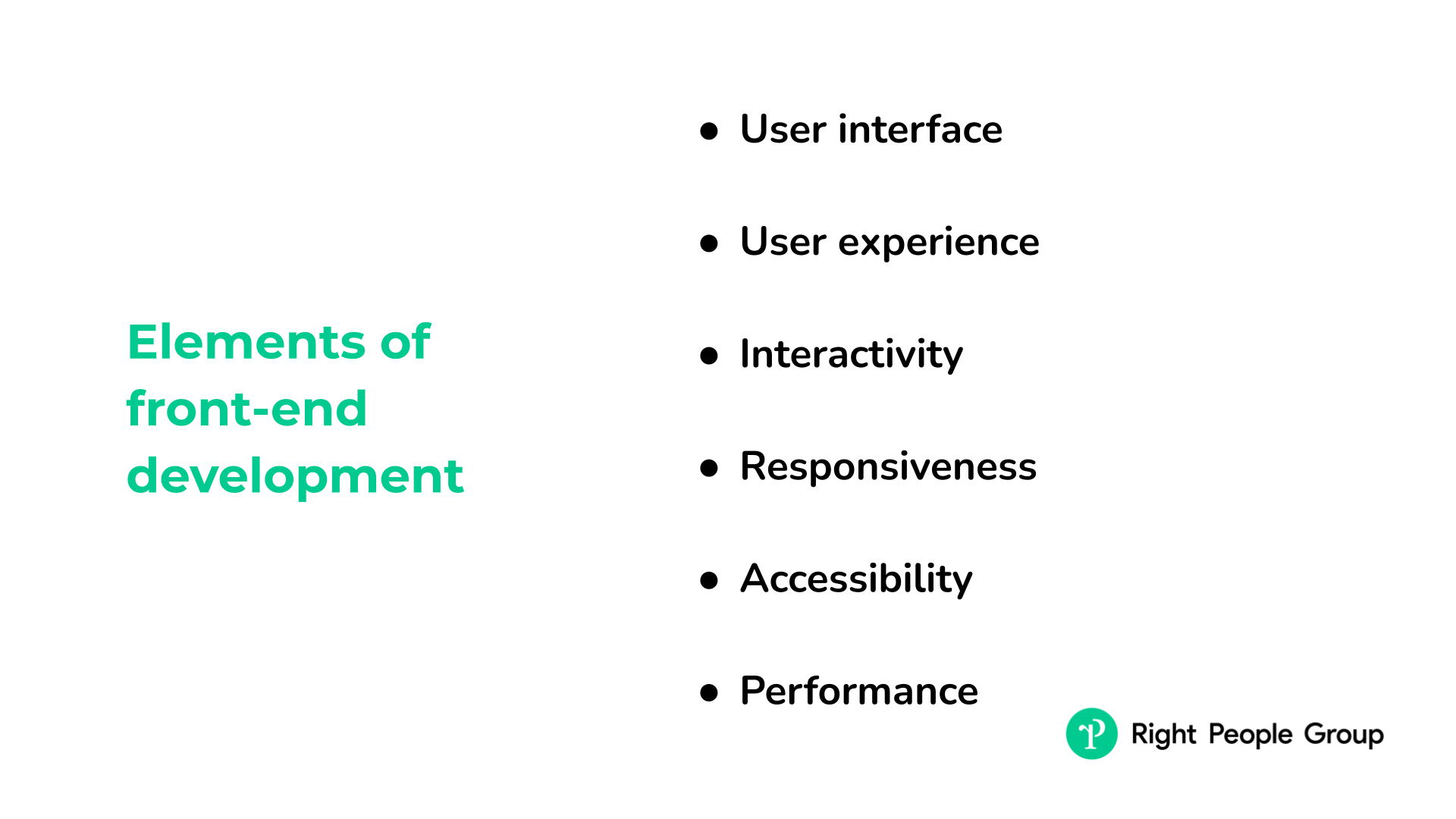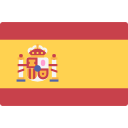For any company that wants to make great web applications, having a skilled front-end development team is really important.
If you’re a hiring manager, it’s crucial to know what roles you need and what skills each person should have. This guide helps you understand exactly who you need on your front-end team and what each person should be able to do.
Understanding front-end development
Front-end development directly impacts how users experience web applications and websites. It’s a mix of design, technology, and user experience, focusing on what users see and interact with.
The elements of front-end development and their outcomes include:

User interface (UI) design: Front-end developers create the look of a web page, including its layout, colors, and text style. A well-designed UI makes the website attractive and easy to use, helping users find what they need quickly.
User experience (UX) design: This part is about making the application easy and pleasant to use. Front-end developers aim to understand what users want and design the application to meet those needs. A good UX means users can navigate the application without confusion or frustration.
Interactivity: This is where elements like buttons and forms come into play. Front-end developers use programming languages and tools to make sure these elements respond quickly and correctly to user inputs, making the application more engaging.
Responsiveness and cross-browser compatibility: Developers work to ensure the application works well on different devices and web browsers. This means users have a consistent experience whether they’re on a phone, tablet, or computer, and no matter which browser they use.
Accessibility: Front-end development includes making sure the application is usable by everyone, including people with disabilities. This is important for reaching a wider audience and making the web more inclusive.
Performance optimization: This is about making the application load and run quickly. Faster websites are more enjoyable to use, and they often rank higher in search engine results.
Essential roles in a front-end development team
For a successful web project, it’s important to have the right mix of professionals in your front-end development team. Each role brings specific skills for creating websites and applications that look good and work well.
Here’s a quick guide to the key roles in a front-end development team
1. Team lead or front-end development manager
The team lead or front-end development manager is an important part of a front-end development team. They need to know a lot about front-end tech like HyperText Markup Language (HTML), Cascading Style Sheets (CSS), and JavaScript, and also be good at leading and managing projects.
They’re different from a regular project manager because they really understand the technical side of building websites and apps, which helps them guide the team better.
Here are the detailed responsibilities and skills needed:
Main responsibilities:
Strategic planning: The team lead sets project goals in line with the company’s vision, ensuring that every development step aligns with these objectives.
Team oversight: They manage the front-end developers, ensuring high-quality work and adherence to project specifications. This includes mentoring team members and fostering a collaborative work environment.
Project management: Responsible for keeping projects on track, managing timelines, resources, and budgets. They address challenges and ensure timely delivery.
Stakeholder communication: As the main point of contact between the development team and other stakeholders, they manage communications, set expectations, and negotiate resources.
Required skills:
Technical skills: A strong grasp of front-end technologies such as HTML, CSS, JavaScript, and frameworks like React or Angular is necessary. They should be able to contribute to and understand the technical aspects of projects.
Leadership abilities: Effective leadership is key to motivating and guiding the team. This includes resolving conflicts, team building, and driving the team towards achieving common goals.
Project management skills: Proficiency in managing all phases of a project is essential. This includes experience with project management tools and methodologies.
Communication and interpersonal skills: They must be skilled in communicating project goals, providing feedback, and liaising with stakeholders. Building relationships and managing team dynamics are also important aspects of this role.
The team lead or front-end development manager guides the team to deliver projects, combining technical expertise with leadership and project management.
2. UI/UX designer
A UI/UX designer in a front-end development team is key to making web pages and apps look good and work well.
They focus on designing everything users see and interact with, making sure it’s not only nice to look at but also easy to use.
This role is all about improving how users feel and interact with the site or app. Let’s look at what they do and what skills they need:
Responsibilities:
Designing user interfaces: They create the visual layout of web pages, choosing color schemes, typography, and layout that make the site visually engaging and easy to navigate.
Focusing on user experience: UI/UX designers map out the user journey, including wireframes, prototypes, and user flows. Their goal is to make the navigation and interaction with the application seamless and intuitive.
Collaborating with team members: They work closely with front-end and back-end developers, aligning the visual design with technical capabilities and business objectives.
Conducting user testing: UI/UX designers gather user feedback through testing sessions. This feedback is used to refine and improve the design.
Skills:
Mastery of design software: Proficiency in tools like Adobe XD, Sketch, or Figma is essential for creating design prototypes, wireframes, and mockups.
Knowledge of user-centered design principles: Understanding how design elements affect user experience is key. This includes principles like balance, contrast, and hierarchy.
Basic coding knowledge: Familiarity with HTML, CSS, and JavaScript helps in understanding the technical aspects of web design and facilitates better communication with developers.
Empathy and research skills: Understanding user needs and challenges is crucial. UI/UX designers use research skills to create designs that meet the target audience’s requirements.

3. Front-end developer
A front-end web developer take what the UI/UX designer has planned and make it work as a real, interactive website or app. In a web development team, they’re the link between a great design and making it actually happen with code. Their job is to make sure that what you see on the screen not only looks good but also works smoothly and efficiently.
Front-end developers often work closely with the back-end development team. While front-end developers focus on the parts of a website or application that users interact with, a back-end developer handles the server-side operations, like databases and server logic.
Together, they ensure that both the front-end and back-end seamlessly integrate to create a fully functional and cohesive web application.
This collaboration is key to delivering a smooth and efficient user experience.
Here’s a breakdown of their responsibilities and skills:
Responsibilities:
Coding designs into reality: Front-end developers use HTML, CSS, and JavaScript to transform design prototypes into live, functioning web pages. They ensure that every visual element, from the layout to interactive features, works seamlessly.
Ensuring responsiveness: They create websites that adapt and function smoothly across various devices, from desktops to mobile phones. This involves writing flexible code that adjusts to different screen sizes and orientations.
Maintaining cross-browser compatibility: Front-end developers ensure that web applications perform consistently across different web browsers. They address any compatibility issues to provide a uniform user experience regardless of the browser used.
Skills:
Proficiency in HTML, CSS, and JavaScript: Strong foundational skills in these core technologies are non-negotiable. Front-end developers use HTML for webpage structure, CSS for styling, and JavaScript for functionality.
Experience with frameworks: Knowledge of frameworks like React, Angular, or Vue.js is often required. These frameworks help in building complex, interactive web applications more efficiently.
Understanding of responsive design: Developers need a solid grasp of responsive design principles to ensure web applications adapt to various devices and screen sizes.
Familiarity with cross-browser compatibility issues: They should be skilled in identifying and fixing issues that arise when a web application is accessed through different browsers.

4. JavaScript developer
A JavaScript developer specializes in creating interactive elements within web applications, working alongside front-end developers to enhance user engagement and interactivity.
Front-end developers typically have a good grasp of JavaScript, so they can handle basic interactive elements.
However, for more advanced interactivity or when working on complex projects, the specialized skills of a JavaScript developer can significantly enhance the user experience and functionality of the application.
Without them, the team might be limited in implementing sophisticated interactive features.
Responsibilities:
Scripting dynamic elements in web applications, like menus and forms.
Collaborating with front-end developers to integrate interactive features.
Optimizing performance of interactive components for a smooth user experience.
Skills:
Proficiency in JavaScript and its core principles.
Knowledge of JavaScript frameworks such as React, Angular, or Vue.js.
Experience with AJAX, JSON, and web APIs for responsive and dynamic functionality.
5. Accessibility expert
An accessibility expert maes sure everyone can use web applications, including people with disabilities and those on mobile devices. They focus on creating web content that’s easy for everyone to access and use, no matter their situation.
An accessibility expert has a specialized role that’s really important, and it’s not as simple as it might seem. While other team members can handle basic accessibility tasks, an expert brings a deep understanding of how to make web applications work for everyone, including people with a wide range of disabilities.
Without this expertise, you risk leaving out a significant portion of users, which can affect both the reach and the quality of your web applications.
Responsibilities:
Implementing accessibility standards: They ensure web applications comply with WCAG (Web Content Accessibility Guidelines) and other accessibility standards.
Testing for accessibility: Conducting regular audits using various accessibility testing tools to identify and rectify accessibility barriers.
Advising on accessible design: Collaborating with designers and developers to incorporate accessible features from the early stages of development.
Skills:
In-depth knowledge of WCAG guidelines: Understanding the requirements for different levels of web accessibility.
Proficiency with accessibility testing tools: Using specialized tools to evaluate and improve the accessibility of web applications.
Familiarity with assistive technologies: Understanding how users with disabilities interact with web applications using technologies like screen readers.
6. Quality assurance (QA) tester
A QA tester brings a professional and systematic approach to finding and fixing problems before the product goes public.
QA testers use specific methods and tools to thoroughly check the app for issues that regular users might not notice.
This helps ensure the app works well and provides a good user experience from the start, reducing the chances of users encountering frustrating bugs or glitches.
Responsibilities:
Identifying and reporting bugs: QA testers rigorously test web applications to find bugs, glitches, and any other issues that could affect functionality or user experience.
Evaluating usability: They assess the application from a user’s perspective to ensure it is intuitive and easy to navigate.
Ensuring quality standards: QA testers verify that the application meets the required quality benchmarks before it is launched or updated.
Skills:
Keen attention to detail: This is essential for identifying even the smallest issues in an application.
Experience with testing methodologies: Knowledge of various testing methods, such as manual testing, automated testing, and performance testing, is crucial.
Understanding of user expectations: QA testers need to understand what users expect from the application to ensure it meets their needs effectively.
7. DevOps engineer (optional)
A DevOps engineer focuses on the infrastructure and processes that support efficient development and deployment of web applications.
Responsibilities:
Managing infrastructure: They handle the setup, maintenance, and scaling of the infrastructure that hosts web applications.
Overseeing deployment pipelines: DevOps engineers streamline and manage the processes for code deployment, ensuring smooth and continuous delivery.
Enhancing the development process: They implement practices and tools that improve the efficiency and reliability of the development lifecycle.
Skills:
Proficiency in CI/CD pipelines: Expertise in continuous integration and continuous deployment is crucial for automating the development and deployment process.
Knowledge of cloud services: Familiarity with cloud platforms like AWS, Azure, or Google Cloud Platform is important for managing scalable web application hosting.
Understanding of version control: Skills in version control systems like Git are essential for tracking and managing changes in the codebase.
The role of a DevOps engineer is often considered optional in a front-end development team due to various factors:
Project scale: Smaller projects may not require the specialized skills of a DevOps engineer, as their tasks can be managed by the existing development team.
Budget constraints: Limited resources might lead organizations, especially startups, to prioritize roles directly involved in product development.
Integrated skills: Developers in modern teams frequently possess a mix of skills, including basic DevOps tasks, reducing the need for a specialized role.
Cloud services: Advanced cloud platforms can automate many DevOps functions, lessening the necessity for a dedicated engineer.
Hiring freelancers for your front-end development team can give your team more flexibility and brings in special skills when you need them.
Using freelancers in front-end development teams
Hiring freelance consultants for your front-end development team can be a smart choice. It gives your team more flexibility and brings in special skills when you need them.
Here are some reasons why bringing freelancers on board can be good for your projects:
More flexibility
Easy to change team size: You can quickly add freelancers when you have a lot of work and scale back when things are quieter.
Hire for specific projects: For unique or short-term projects, you can bring in freelancers who have just the skills you need.
Special skills
Expert knowledge: Freelancers often focus on one area and can bring deep knowledge to your project.
Up-to-date techniques: Since freelancers work on many different projects, they’re likely to know the latest trends and tools.
Saves money
Lower ongoing costs: With freelancers, you don’t have the same costs as hiring full-time employees.
Spend money as needed: You can use your budget more wisely by hiring freelancers for certain tasks instead of full-time staff.
New ideas
Different viewpoints: Freelancers can offer new ideas because they’ve worked on various projects and in different industries.
Creative solutions: This mix of experiences can lead to more creative ways of solving problems.
Complements core team
Extra help when busy: Freelancers can help your full-time team when there’s a lot to do, helping you meet deadlines.
Best of both worlds: A team with both full-time staff and freelancers can be very effective, combining steady work with new skills and ideas.
Looking for the right front-end development team?
Building a user-friendly web application requires a team with specific skills and expertise. Finding these professionals can be challenging and time-consuming.
We have been connecting businesses with top IT talent, including front-end development experts, since 2007. Our service is known for its efficiency and effectiveness in matching the right people to the right projects.
Choose us for your staffing needs and here’s what you get:
Quick matching: We value your time and work quickly to find you the right team members.
Quality assurance: Our professionals are among the best in their field. Learn about our selection process.
Personalized service: We understand every project is unique and find professionals who match your specific needs.
Contact us today and let’s us find the right experts for you, fast.
Conclusion
Assembling a front-end development team requires balancing diverse skills and personalities. By understanding the key roles, hiring managers can build a team that is technically proficient and cohesive. The strength of a front-end team lies in its ability to work collaboratively to create engaging and user-friendly applications, keeping up with the latest trends in web technologies and software development.












